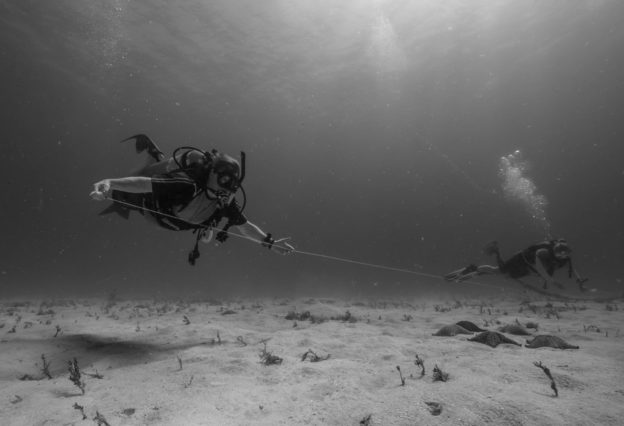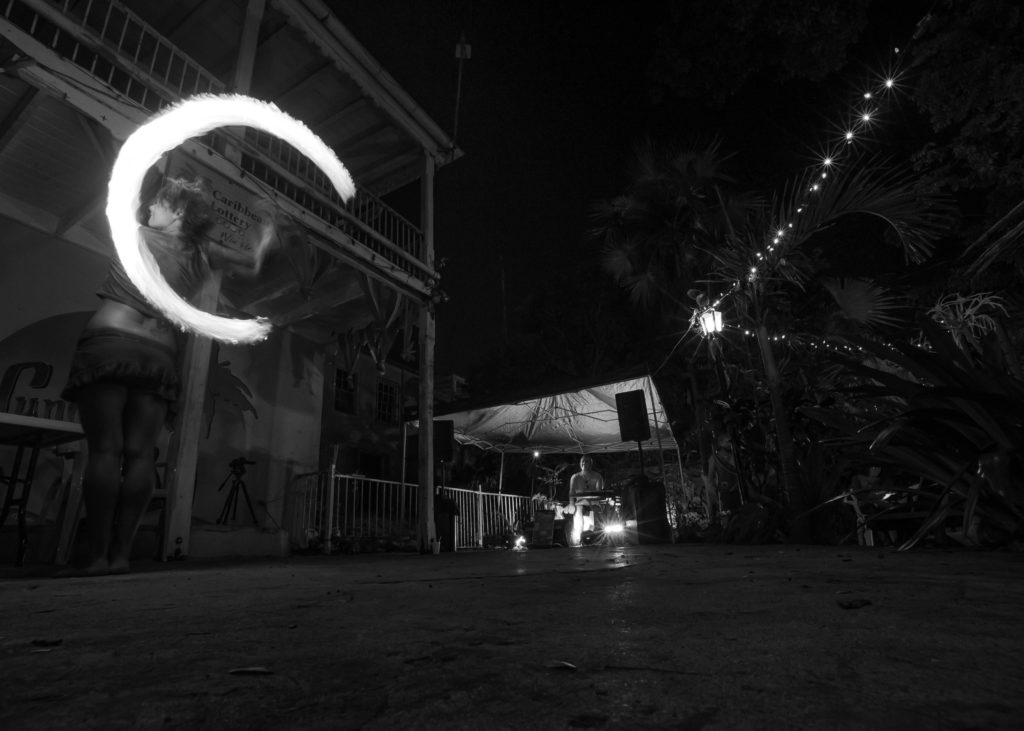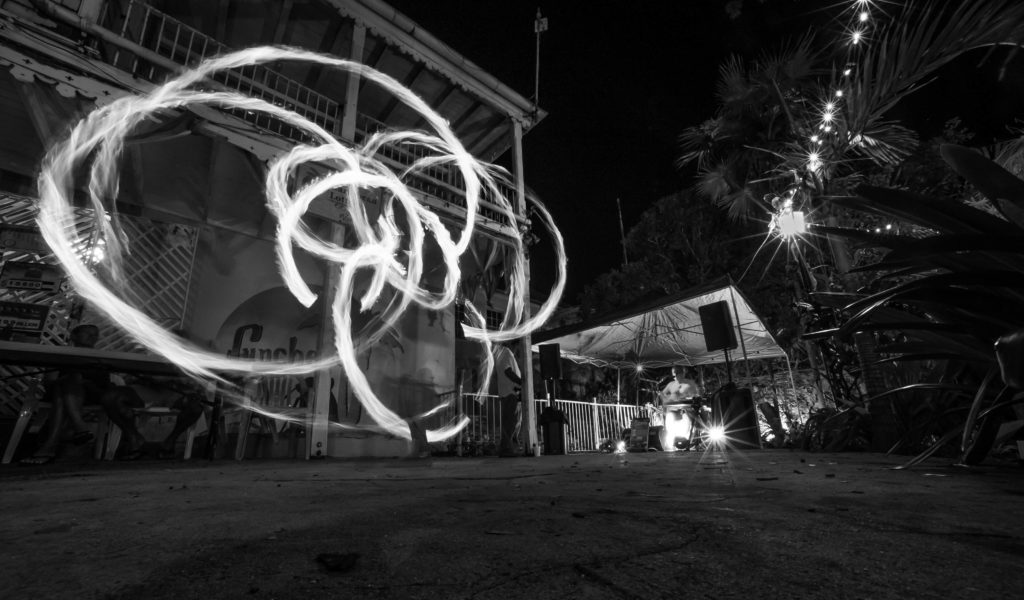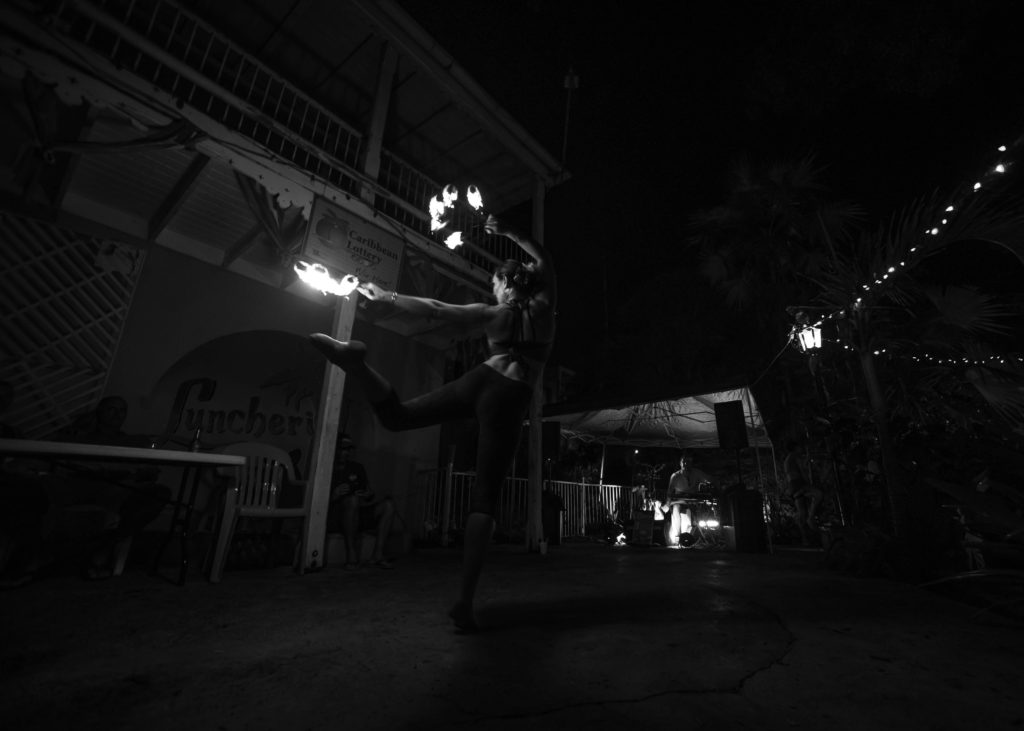It’s 10 AM on St. Croix and I’m about halfway through husking a coconut in the morning breeze when I get a call from Zandy Hillis-Starr (Resource Manager for the National Park Service in St. Croix). “Hi Shaun, where are you?” I know this doesn’t bode well for me. “I have Jen and the NOAA team here waiting on you for a checkout dive.” Yikes! Due to some miscommunication, I had been given the wrong time the night before. Luckily my dive gear is ready to go. “I’ll be there in 15,” I say.
15 minutes later, Jennifer Doerr and Ron Hill from NOAA’s Galveston, Texas office greet me at the boat. With them is Hannah, an intern grad student from Nova Southeastern University. Thankfully for me, they aren’t upset that I set them back this morning. Clayton Pollock (Park Diving Officer) is also there and begins to review boat safety with us. “The fuel gauge is precise, but not always accurate,” he warns. We all laugh and thank him for allowing us to use the well-maintained park boats for the week.

Iguanas make the best dive buddies! Though this one might need a smaller BCD…
Our mission for the week is to tag and measure conch. Conch are a prized snail to eat throughout the Caribbean and Central America. Their beautiful shells are commonly sold in shops. Unfortunately for them, they are snails. Therefore, it is easy for both humans and marine organisms alike to capture them due to their slow moving nature. “I feel bad for the conch, everything eats these guys, especially octopus. Juvenile conch are too easy for them. They really don’t stand a chance,” Jen remarks. On the human side of things, regulations have been put in place on St. Croix, but enforcement has been proven difficult. Jen and Ron have dedicated themselves to tracking these conch for years in hopes of understanding their life cycle and aggregation patterns better. This information can be eventually applied to a management decision, which could bolster the future of conchs in the U.S. Virgin Islands.
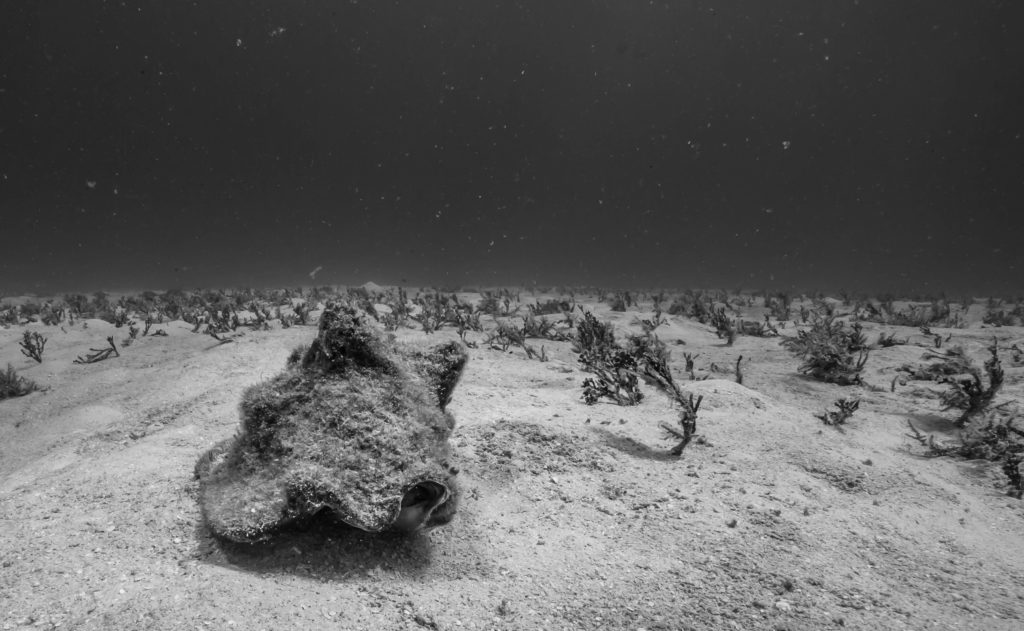
“Conchs are the cows of the sea. They move slow, generally live in herds, and graze in underwater pastures” -Jen Doerr
Ron begins explaining the circular search pattern we will use to find conch underwater. As we get talking, it is apparent Ron has been at this for many, many years. Ron is a jolly guy with a slight southern twang in his voice, though he has lived all over the world- from Indonesia to Puerto Rico. His laugh is contagious and famous throughout NOAA’s dive team. “We are only tagging a couple conch and then measuring the rest. Jen will be topside support and putting the actual acoustic tags on the conch,” Ron tells me. NOAA has put in acoustic receivers all over the seafloor around St. Croix’s north shore. Anytime a tagged conch comes within a given distance of the receivers, the receiver logs the time that the conch passed by.
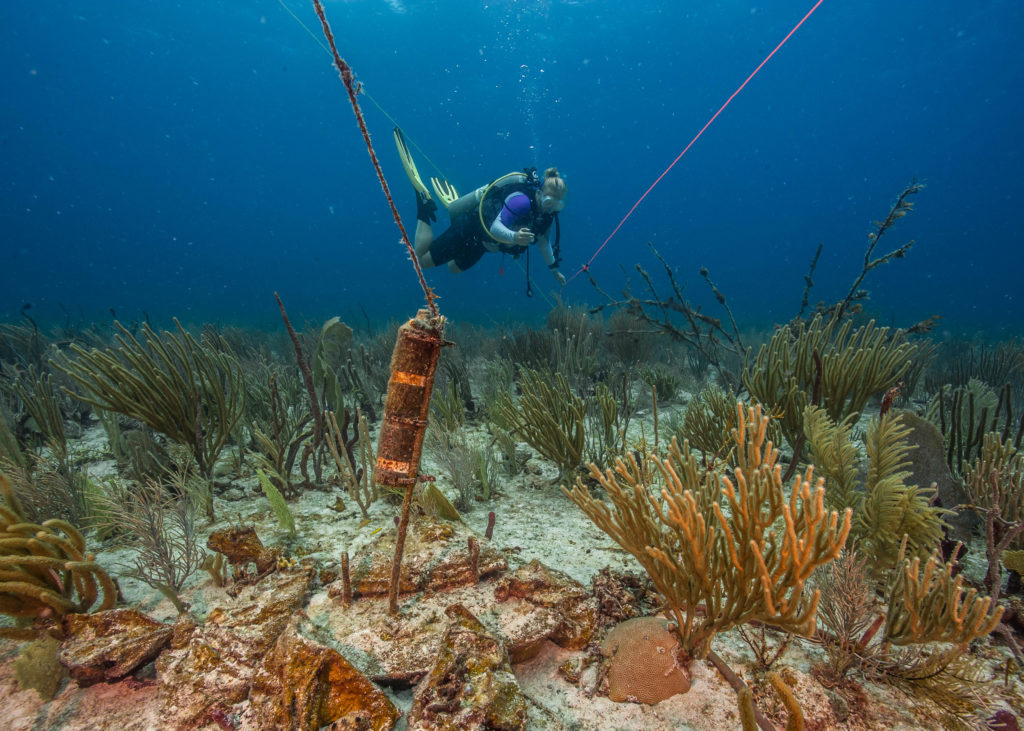
The black canister is a hydrophone. This is what allows all involved parties to track conch, among other things.
The checkout dive involves a couple of skills and then practicing the conch tagging protocol. We don’t find any conch, but I do find Ron’s fins peculiar. I’ve never seen anything like them. They are called Force Fins. Your foot sits on top of a thin plastic/rubber sheet that is forked at the end and there is a little foot box on top of that. “The military used to use these things, you can really move with them!” Ron says. They make my Jet Fins look like 18-wheelers. I watched Ron get good speed with them, but I still can’t believe that they work.
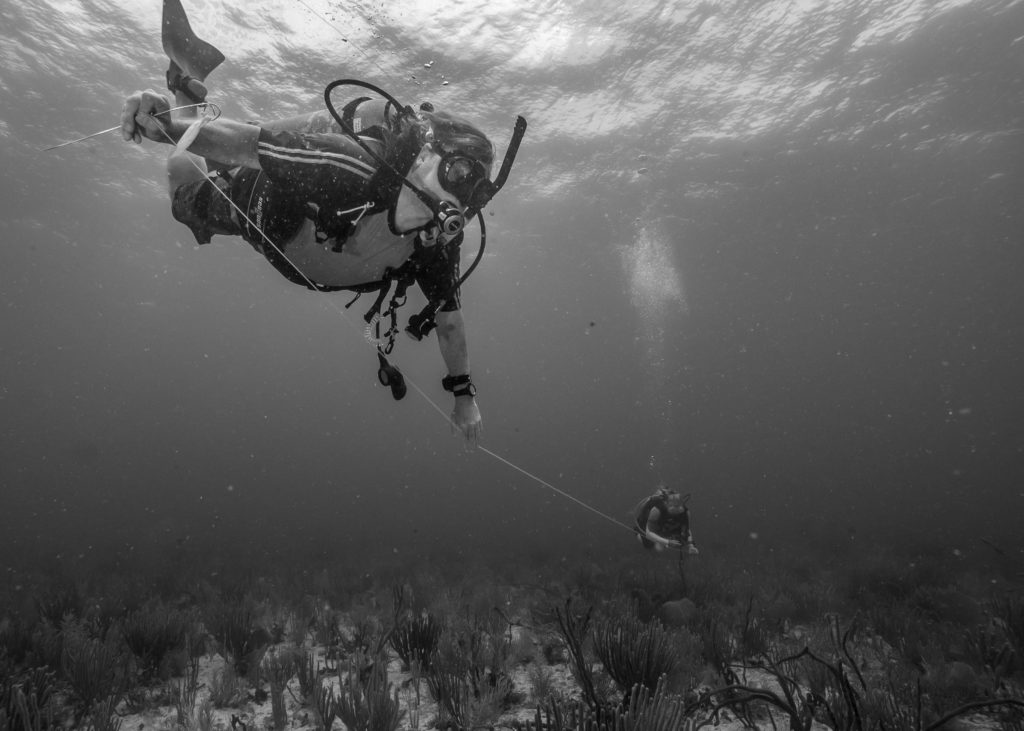
I didn’t get a great shot of Ron’s fins, but you can kind of see them here as he runs a search pattern with Hannah.
Back at the dock, Hannah is rinsing gear. “Wow, this water really has a nice spread to it,” she says. “It is pretty light and fluffy, isn’t it,” I respond. “Light and fluffy?! I’ve never heard anyone describe water as light and fluffy, but that’s pretty accurate,” Jen laughs.

Inside the small but mighty Fort Christiansted.
Since we finished early today, I decide to check out Fort Christiansted- a historical fort that Danes built when Denmark ruled the islands. Though small, the fort has excellent informational displays throughout its halls and helped inform my understanding of the island’s history. Before the U.S. Virgin Islands, the islands were known as the Danish West Indies. Denmark took control of the islands in the early 1700’s. Slave labor powered lucrative sugar cane and rum industries on St. Croix, which helped Denmark out financial slump in the mid 1700’s. The fort provided two services. First, it provided some security in case of a slave-led rebellion. Second, it protected the island/Denmark’s financial assets from sea-faring attacks. As time progressed and Denmark outlawed slavery, the island was less productive financially. In 1916, the U.S. purchased the islands from Denmark for $25 million, which coincidentally coincided with the establishment of the National Park Service… (more on this next blog)
For the first time in 3 days, the wind is low and the swell is down. These conditions give us the opportunity to dive around Buck Island Reef National Monument. “This must be a very romantic area,” Ron remarks. We see mating turtles for the fourth time in three days leaving the marina. Turtle mating season is in full effect and the National Park Service turtle team has been seeing nesting turtles every night on Buck Island.
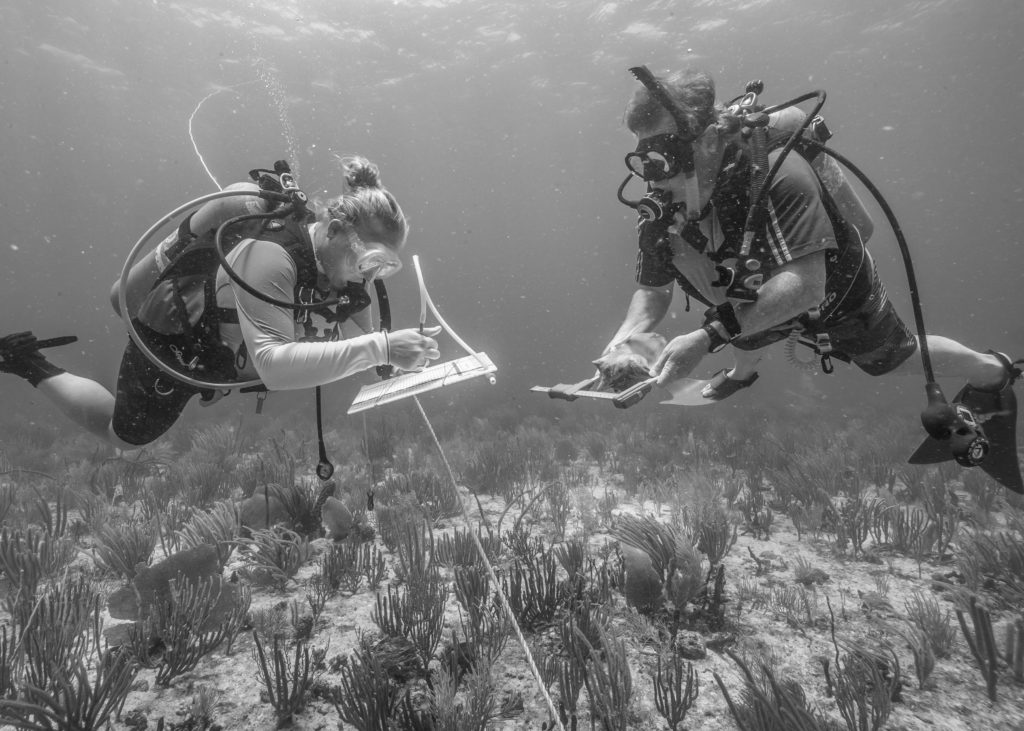
Maintaining proper buoyancy while taking data and measuring conchs can be a challenge!
As we pull into the scuba shop to pick up more scuba cylinders, I see Laura Palma, an intern that I worked with on a turtle grazing project last week. When we get to Buck Island, I see a guy named Mike that I’d met a few nights back in town. In the water, I see my new housemate Brennan. “How do you know everyone?!” Jen asks me. “I guess this island is smaller than I thought!” I reply. After a mere week and a half on St. Croix, I can’t go anywhere without running into people I know. I’m certainly not an introvert, but the small, friendly community Clayton told me about has proven very true.
The diving at Buck Island is spectacular as it gets for sea grass diving. “Conch are the cows of the sea. They move slow, generally live in herds, and graze in underwater pastures,” Jen tells me. More often than not, sea grass diving can be fairly murky. However, Buck Island’s sea grass beds have clear, warm, bright blue water and more importantly, lots of conch. Up until this point, we’d been diving at Salt River and seeing only queen conch- the most colorful and prized conch (for their shells). At Buck Island, we finally started to see milk conch (more prized for eating). Ron hands me the first milk conch we see and signals for me to bring it back up to the boat.
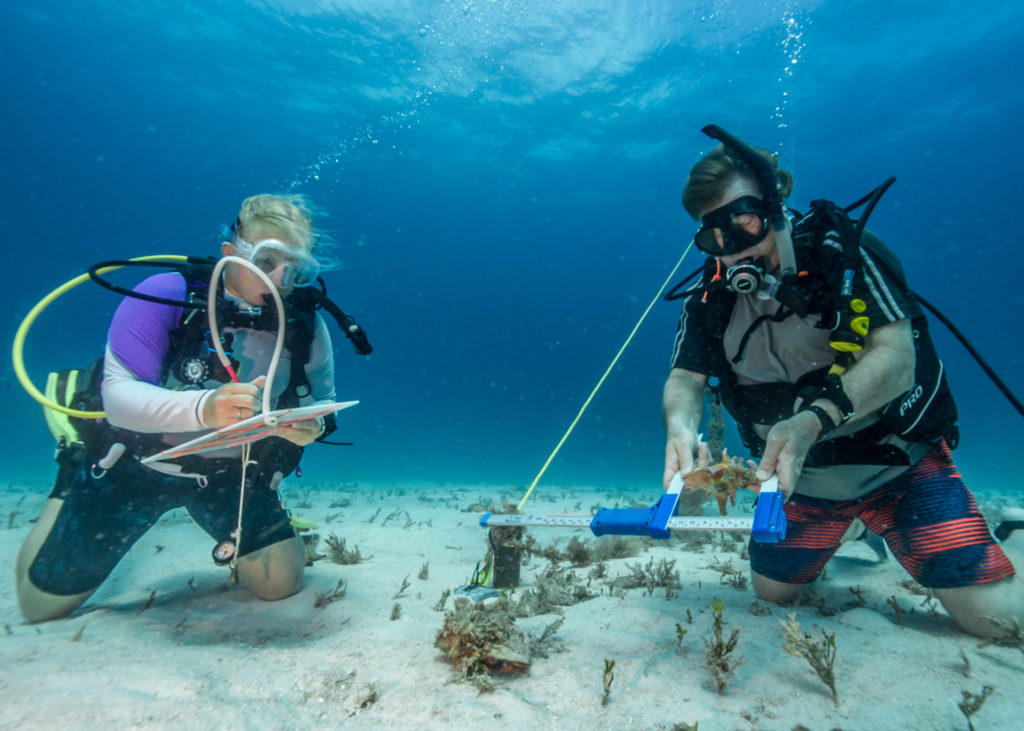
Ron and Hannah measure a conch near Buck Island.
“Ohh!! A milky!” Jen lights up when she sees our new friend. Jen is an impressive person. Growing up in the mountains of Idaho, she is a strong female mountain woman that muscled her way through the male-dominated fisheries industry to get to where she is now. Her work ethic is an inspiration to the NOAA team and myself.
As Jen measures the conch and preps a tag to secure to the spires on the shell, it hits me. The dedication and passion of this team in unbelievable. They travel over 2000 miles each way every year (for decades in Ron’s case) to protect snails that they otherwise have no relationship to. These are not conch near their home in Texas that mainland fishermen are taking. Rarely have I seen a team so passionate about marine organisms that are so far away from their home base.
“Carrots and peanut butter again?!” Jen asks. “It may not be light and fluffy, but it is a backpacker’s delight!” I say, as the joke of light and fluffy has carried on through the week. I’ve had carrots and peanut butter everyday as part of my snack for the entire summer due to the transport-friendly nature of both foods.
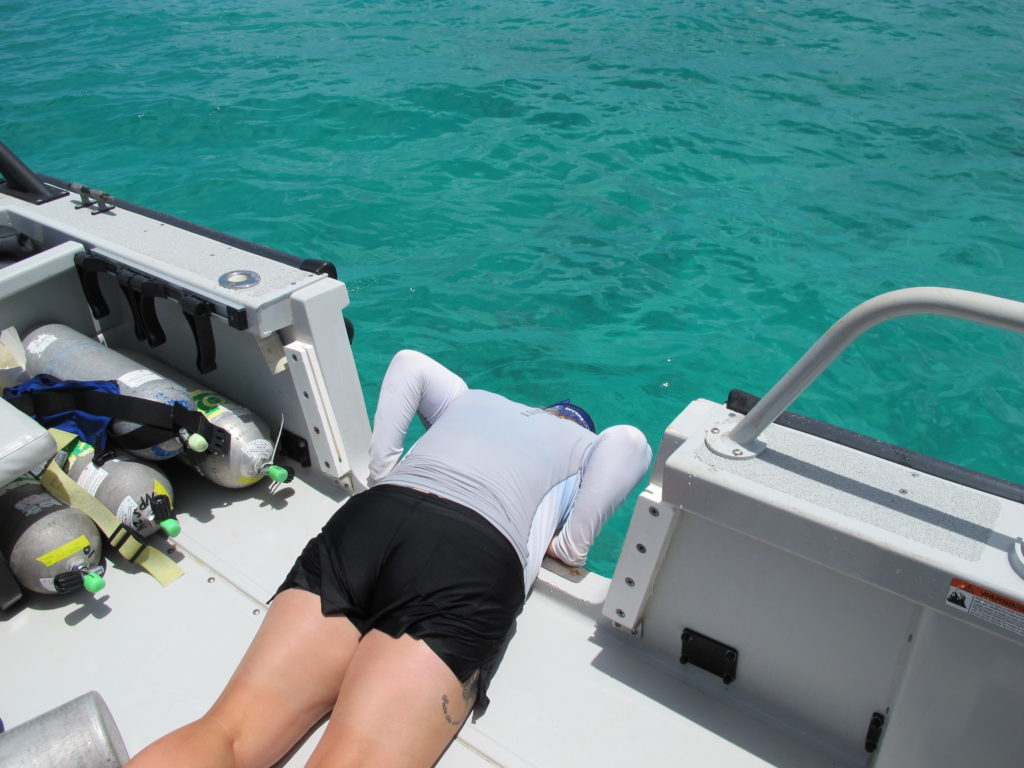
Hannah “pulls a Seth.” Seth Kendall, a former Pennington Marine Science Center Intern that I worked with on Catalina Island, used to put his face in the water off the side of the boat to check the dive site location. His legacy lives on in St. Croix after I showed the NOAA crew how to do it.
Lunchtime on the water at Buck Island is incredible. The water is still and crystal clear. You can see every fish and coral head from the boat. Luckily, we get some time to jump in and snorkel for conch. “I think this might be a dive. It’s definitely looking like a dive to me!” Ron says. Ron has the enthusiasm of someone half his age when it comes to diving and is always pushing to dive, even if the water is only 10 feet deep. “Pretty sure you can do this on snorkel guys,” Jen laughs, as conditions couldn’t be better for snorkeling.
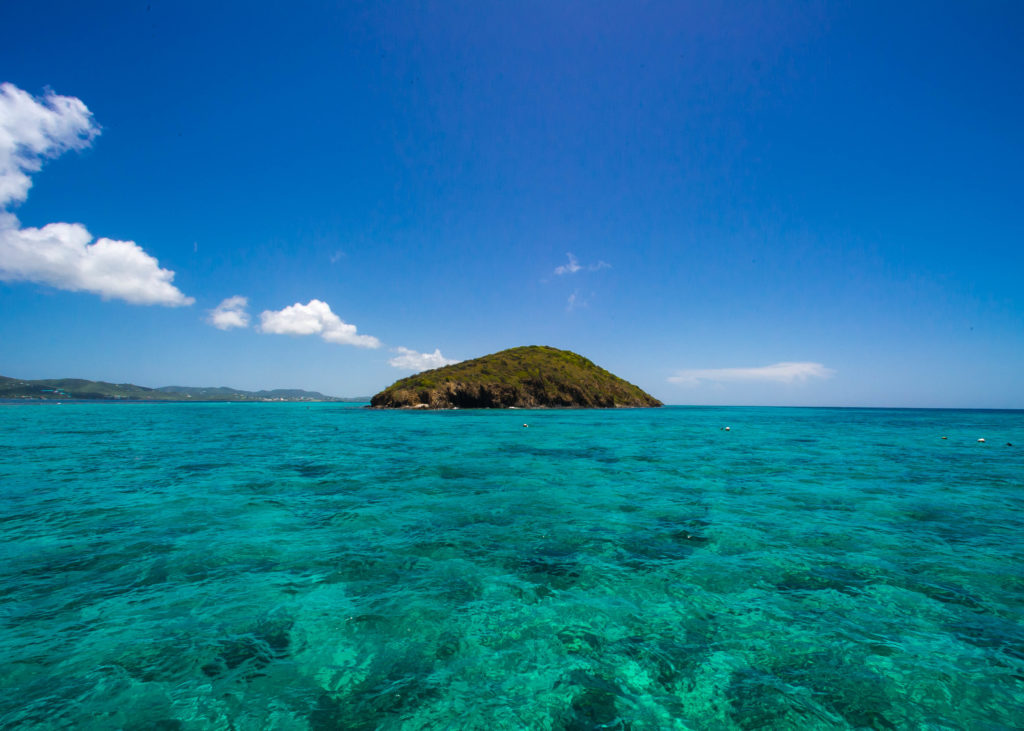
Buck Island speaks for itself.
“Anyone want some elixir?” Hannah asks, referring to her homemade baby shampoo-based anti-fog for scuba masks. “You mean Hannah’s Spit®?” I quip as she laughs. The running joke of the week is that Hannah’s anti-fog is really just her spit (divers most commonly use spit for anti-fog) that she has bottled up and brought on board to try to sell us on. Hannah is a warm, wholesome, hard-working Minnesotan who is as good of a team mate as you could ever ask for. Though when I say she is warm, I mean that both figuratively and literally- she lives in a perpetual state of sunburn in the Virgin Islands thanks to her fair Scandinavian complexion.
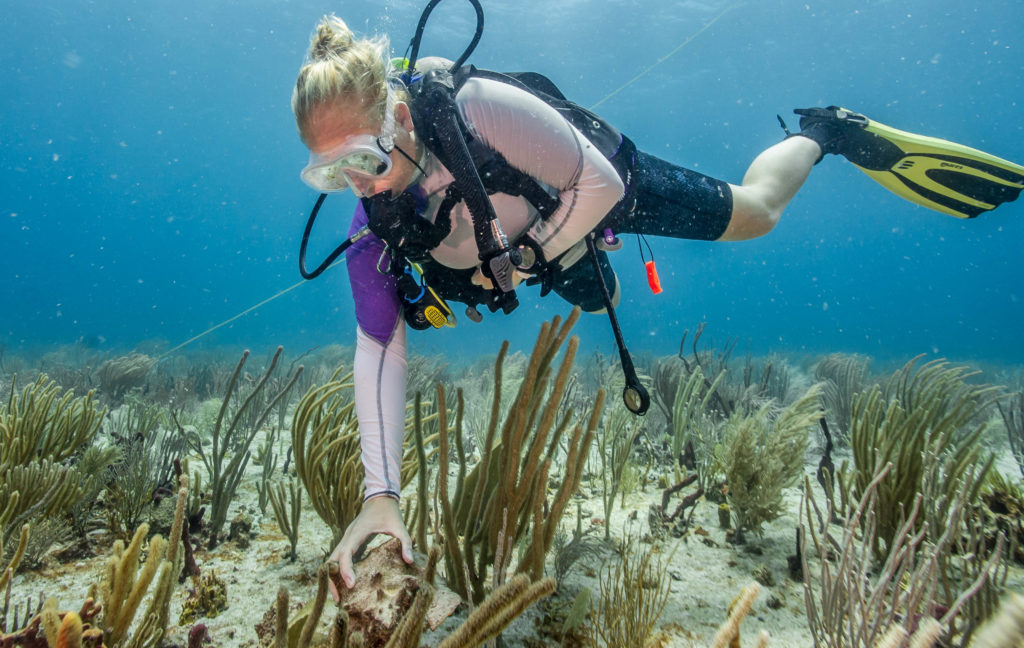
Hannah puts a conch back after measuring.
As soon as I hit the water, a small bar jack swims right underneath my stomach. I swim out a little further, and the bar jack keeps with me. When I dive down, the bar jack dives down with me and grabs a snack off the reef. This little fish stays with me for over an hour in the water and swims what was likely about one mile underneath my stomach. I feel ownership over this little fish. I make sure to never leave the fish behind and chase off potential predators like barracuda to protect my bar jack. After I see a school of cuttlefish, a giant bar jack leading two nurse sharks through the reef system, and lots of parrotfish, I drop the bar jack off with its school under the boat and get on board.
Not having my camera this time was a tough pill to swallow for me. I am a fish person. I love fish and care about them as much as I do mammals. It is incredibly difficult to get people to have this type of relationship with fish. Having an image to capture this experience would really help bring these little fish to life and get people to care about fish not just for the purpose of eating, but for the purpose of having more fish in a healthier ocean.
It’s my last day to dive in St. Croix since I’m flying out in two days. Everyone that I have ever met that has been to St. Croix has told me to dive the famous dive site called “The Wall” at Cane Bay. I have texted everyone I know on the island (which is a surprisingly large rolodex at this stage) nearly every afternoon of my stay trying to find a dive buddy for The Wall. Unfortunately, it seems that diving after a long day of work can be a hard sell. Today is no different.
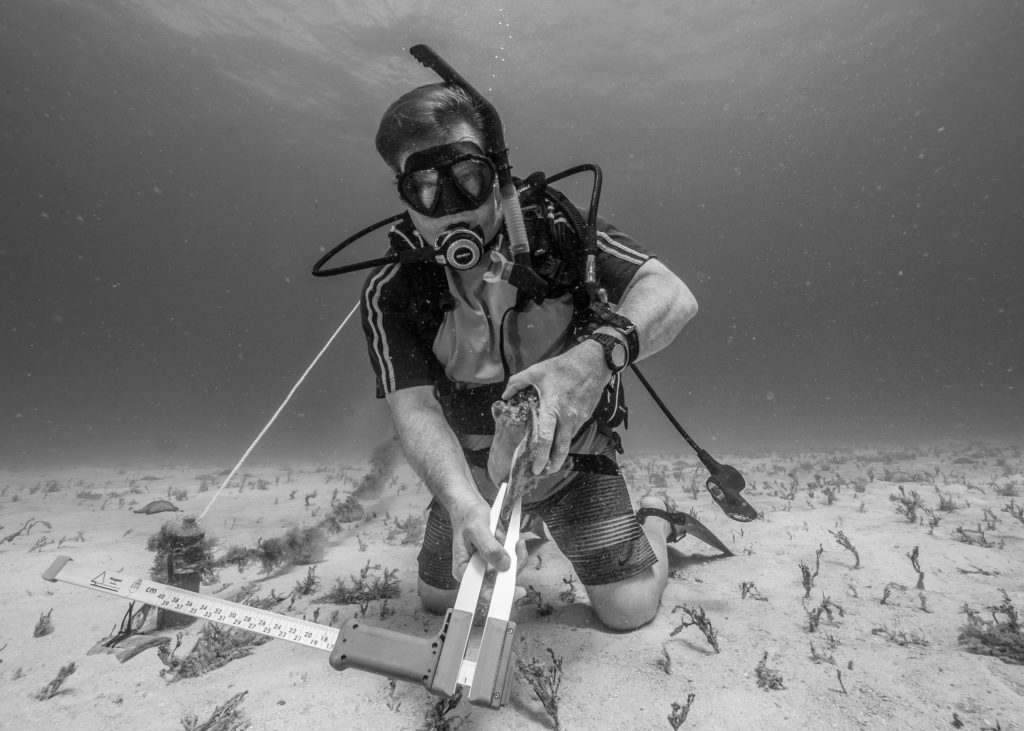
The flare of the conch, which is what Ron is measuring here, is how we can estimate the age of a conch.
“I think I’m just going to go and hopefully someone needs a dive buddy there,” I tell my housemate as I hop in the car and head for Cane Bay. I decide not to bring my camera. Some friends of mine have told me that it is not safe to leave things in your car at Cane Bay. Since I’m unsure of the area and whom I’ll be diving with, I decide it will be safer to not bring the camera. I don’t want to be marked as a target and I want to be able to respond to an emergency if I end up diving with a freshly-certified diver.
Sure enough, Eric from Pittsburgh is trying to dive The Wall when I pull in. Luckily for me, he’s logged a few dives at the wall and knows the site well. Unluckily for me, the area is much safer than I thought it would be, Eric is a rescue diver, and I don’t have my camera.
The Wall is breathtaking. It lives up to all it is billed to be. You descend onto a horse from a merry-go-round that is planted on the sea floor. 20 meters further is a wall- a seemingly infinite drop off, where the sea floor goes from 60 feet to several thousand. We see turtles, sharks, the healthiest coral I’ve seen all summer, and an incredible diversity of fish.

I may not have gotten any photos at the wall, but I did find these sea stars in a flying-v pattern at Buck Island!
When we come in, I say bye to Eric from Pittsburgh and say hi to Madelyn Roycroft (California Polytechnic San Luis Obisbo grad student from last blog) and her team. Cane Bay is about a 45 minute drive from Christiansted, where I am based. This is truly a small island. “I think I’m going to try to get out to Point Udall (the most eastern point in the United States) this weekend for sunrise if you guys would be interested!” I tell them. Hannah Rempel, a member of Madelyn’s research team jumps at the opportunity, “I’m a morning person- absolutely!”
I leave after making tentative plans with them and get a message from Clayton. “Hey Shaun, just wanted to check in. I think we got to hang out a bit when you first got here but I haven’t seen you much since. What are your plans before you leave? Let’s hang out.” I am genuinely happy to hear from Clayton. I had heard so much about Clayton and the entire NPS team on St. Croix before the summer from previous Our World-Underwater Scholarship Society® National Park Service Interns. In the little time that I have spent with them, they made quite the impression on me. They are one of the hardest working, most professional, and most fun units I’ve met this summer. However, they are in turtle season. Therefore, I haven’t seen them much since they are in full-noctural mode, on a 6 PM to 6 AM schedule.
Music plays loudly inside of a beautiful courtyard laced with the smell of Mexican food from the restaurant inside. It is my last night in St. Croix and I decided to watch my friend Jeff Jung (mentioned last blog, St. Croix resident and former high school classmate of mine) and his girlfriend fire dance. The heat from the torches is sweltering, but I decide to get as close as possible to get some photos. I’m sweating uncontrollably for the entire performance, but looking at the photos as they are shot keeps me motivated. A woman then comes out with a single fireball and spins it wildly, creating a trail of fire across the deep blue sky. It’s a mesmerizing effect, but I remain focused on getting the shots I want. The creative process of finding the right settings, angles, and light to create the vision in my head is simultaneously one of the most frustrating and rewarding experiences I have ever had. It’s what keeps me going as a photographer.
- Not slow, not fast. This is how I set my shutter speed to create a small fire trail.
- This time I set the shutter speed a little slower and got lucky that the dancer didn’t move.
- This is a fairly slow shutter speed shot, while the dancer was moving extremely quickly. The result? A long fire trail.
- A freeze frame capture of some St. Croix fire dancing.
After the performance, I say my goodbyes to Jeff, his girlfriend, and all of their friends that I have come to know over the past two weeks. I don’t stay too late though, because I have one more goodbye to say. I hop in the car and drive over to Jen’s hotel. I thank Jen for giving me the opportunity to dive with her and the team for the week. The conversation turns, as we discuss the rollercoaster of life and the wild places that call each of us. As passionate as Jen is about the conch in the Caribbean, nothing makes her feel more at home than the snowy mountains around Idaho and Wyoming. She has lived quite a few places and loves Galveston, but the mountains hold a special spot in her heart. I really connected with her on this, as Catalina Island feels that way to me. In my internship summer, it has proven true time and time again- as incredible as the work is and as passionate as I am about photography and marine conservation, establishing a relationship with the people I work with is equally as rewarding.
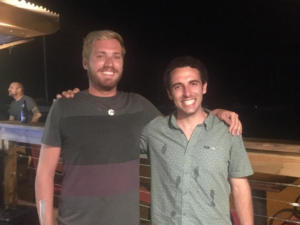
Jeff and I, reunited 3,500 miles away after 10 years. Contrary to popular belief, those are raindrops, not tears on my shirt.
It’s what I like to call “dark o’clock” in Christiansted. I am never up at this hour, but I’m meeting with a research team from Cal Poly San Luis Obispo at 5AM to go to Point Udall for sunrise. Hannah’s excitement was contagious enough to convince the rest of the team to come too. “I’ve done this for three years in a row on St. Croix, so I had to come!” Madelyn states.
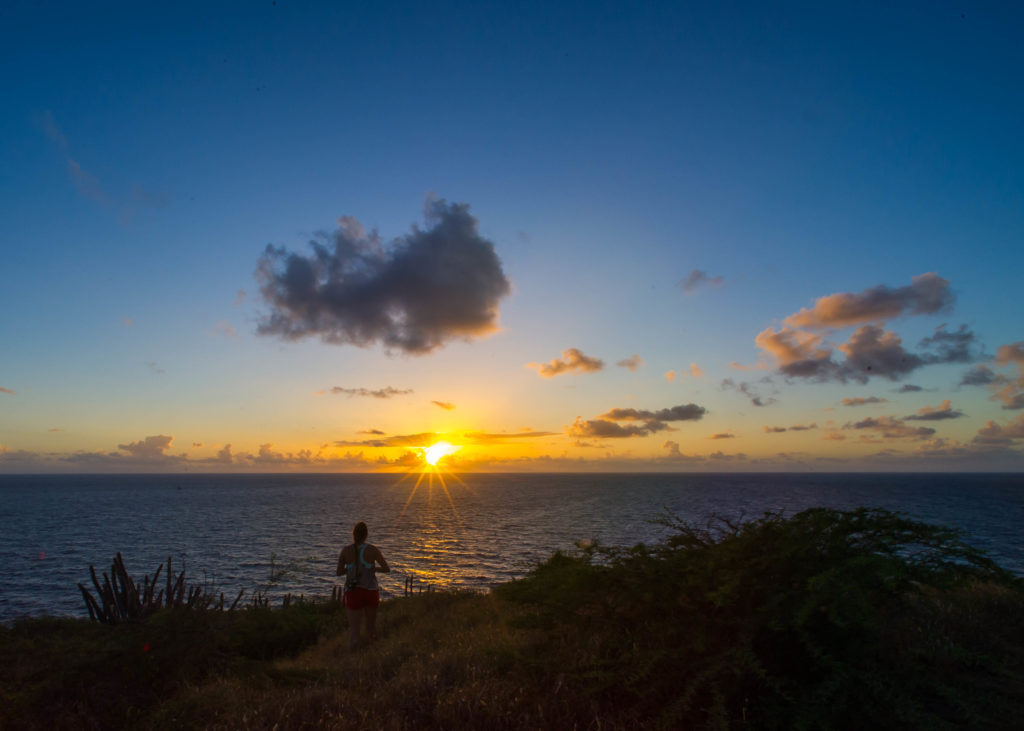
Sunrise over the most eastern point in the United States.
Upon arrival at Point Udall, I’m still half asleep and the sun is still below the horizon. We all hop out and take photos of the beautiful landscape capped off by Buck Island sitting in the background. Just as a beautiful pink cloud rises above the island behind us, the sun starts to rise from the ocean and shoot out beautiful orange rays in the sky. I am not a “morning person” and 4 hours of sleep certainly doesn’t help, but watching the sunrise at Point Udall reminded me that getting up early for the outdoors is always worth it.
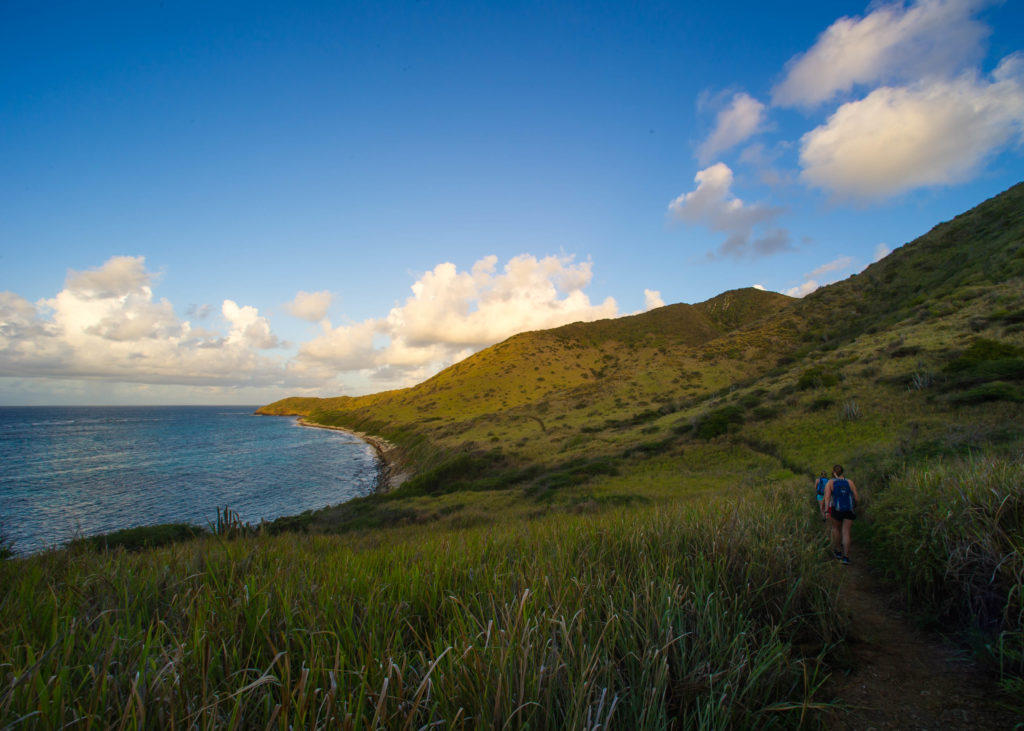
The beach near Point Udall was fun to explore and full of ideal turtle nesting grounds.
“I love these passion fruits! Thank you so much Clayton!” a local woman says as she takes a bag of passion fruit from Clayton. Clayton and I are having lunch right before I catch a flight to St. Thomas as customers in the restaurant say hi to him intermittently. After living on the island for nearly a decade, Clayton seems to know everyone. We chat for a while over a few arepas and I thank him for everything he did for me on St. Croix. I would have been in serious trouble without him. “You know you have a place to stay out west with a STOCKED fridge, if you are ever insane enough to go to colder waters,” I say as my parting message to Clayton. “Be careful of what you wish for, we just might take you up on that!” he responds. I sincerely hope he does.
The scene in the restaurant is representative of both the St. Croix and National Park Service communities- tight-knit and friendly. I came to St. Croix as unprepared as I could be, and ended up having a wonderful experience working with some amazing people. Looking back, I wouldn’t change a thing, and the flexibility required of me during my first week is a skill I’d need to utilize at my next stop in St. John.
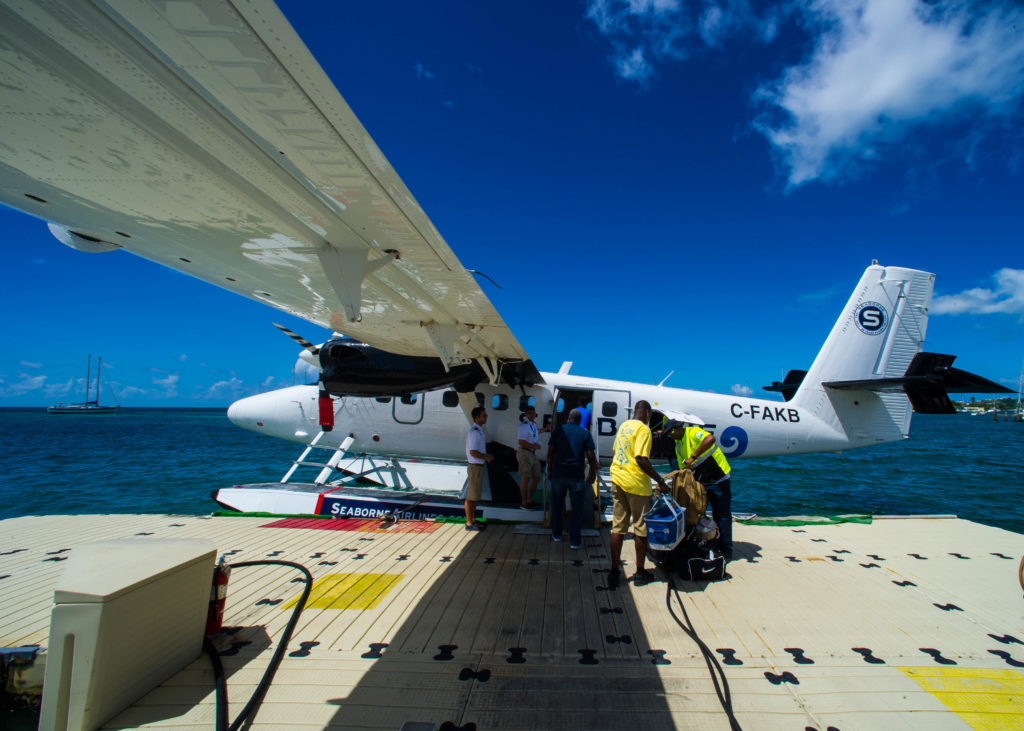
The seaplane I’ll be taking to St. John!

